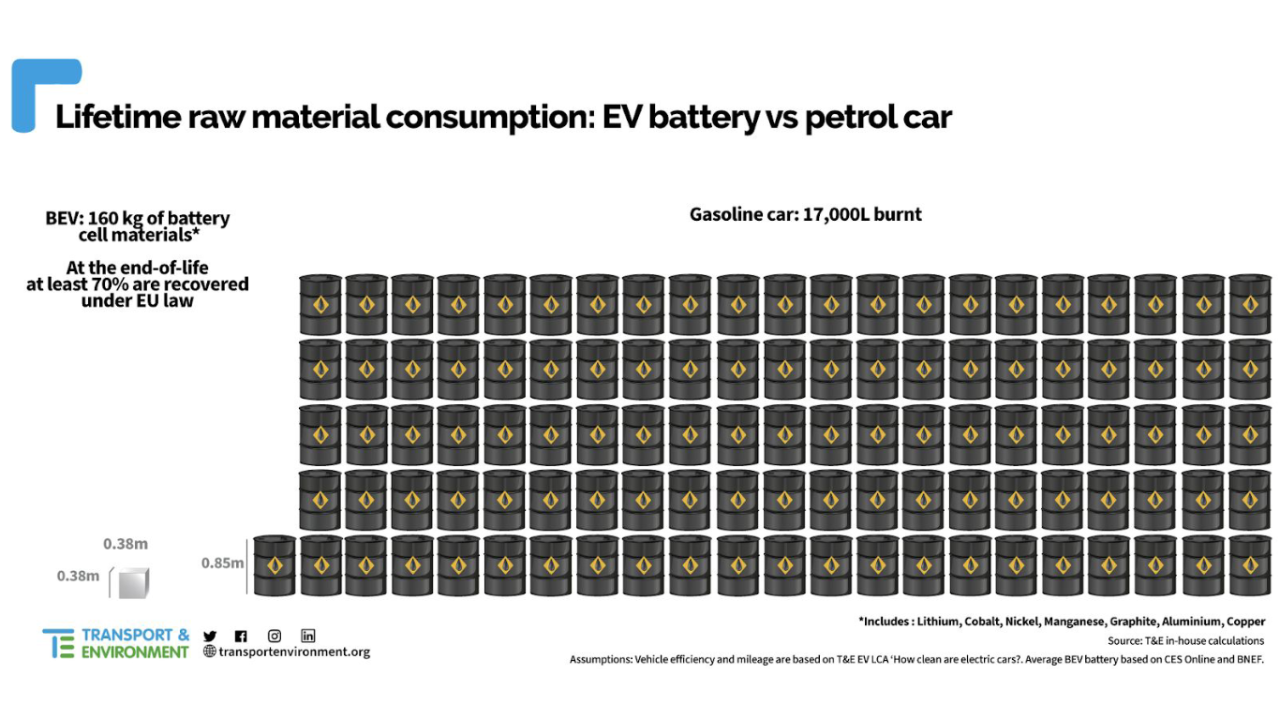One of the biggest concerns people have with electric vehicles and the shift to electrification in the transport industry is lithium – a type of metal that is essential in batteries. Our dependence on lithium, the potential of running out, and the reliability of lithium are often the backbone of arguments surrounding electric vehicles not being that environmentally friendly.
The way it’s often posited to me is ‘electric vehicles aren’t really environmentally friendly because lithium requires mining’, and on the surface, it’s a concerning idea, but it’s also quite easy to defuse.
This argument is often deployed as a way of discrediting electrification, and instead sticking with ICE vehicles, but here’s the thing: EVs don’t require mined-for resources to recharge for daily use, while ICE vehicles do.
Transport and Environment, a clean transport campaign group in Europe, visualises this really well in a report from March 2021.

The above visualisation discounts that electric vehicles can still be dependent on fossil fuels through grid-based charging, but we’re slowly shifting away from this. In particular, in 2021, 29 per cent of energy generated in Australia was created using renewable energy, a figure that has been going up for decades.
Battery replacements are also a valid concern, which are expected to occur well into the lifetime of an EV, between 10 and 20 years. It’s hoped that replacement batteries would at least be partially built using reclaimed parts. Of course, until that’s the norm, replacement batteries will still need to be sourced from newly mined resources, but it is an advantage that fossil fuel cars can’t match.
There’s also a ‘carbon debt’ argument: electric vehicles often require more carbon during production than ICE vehicles, however, it has been found that EVs can break even on carbon reliance after several years of driving, varying depending on the model.
So, at an individual vehicle level, electric vehicles that rely on lithium are still more environmentally friendly than fossil fuel counterparts. If we start to look a bit more bigger-picture, then we move onto our dependence on mining entirely: if we’re becoming more renewables dependent, then we won’t need to mine for fossil fuels as much. More lithium and rare earth mining, provided that the minerals can be reused across the production supply chain, means overall less mining of fossil fuels (in theory).
But unfortunately, lithium isn’t perfect, and there are environmental concerns to consider. Euro News’ article from November 2022 included some incredible photos of lithium mining operations and descriptions of the impact they have on the local environment.
Lithium extraction has adverse impacts on the environment, like any other mineral that we mine for. However, similar to coal and gas, lithium mining can result in soil degradation, water shortages, biodiversity loss, damage to ecosystem functions, air contamination and, overtime, an increase in global warming. The article above describes lithium as “the non-renewable mineral that makes renewable energy possible”.
It’s a troubling thing to consider that, even as we may try to live and consume more ethically, the sourcing of those renewables may require environmental degradation to some degree. Even if it’s less mining if collated with a focus on recycling and reusing resources, it’s still concerning.
The good news is that researchers are working on ways to cut down on lithium dependence, be it through more efficient motors or sodium-based batteries.
But let’s just touch on overconsumption to end with. It has been argued that some 384 new mines would need to be established internationally to meet electric vehicle demand.
This is a troubling number. According to Statista, there are 2,215 coal mines internationally. According to Investopedia, there are some 1,500 major crude oil fields in the world, where 94 per cent of oil comes from today.
Logic for this would be: as we become less dependent on fossil fuels like coal and oil, we’ll be more dependent on lithium. If that means opening some 300 new mines at the expense of closing an equivalent number of fossil fuel mines, that could be a worthwhile trade. Although, this doesn’t mean we can simply ignore environmental and cultural destruction issues.
Gizmodo writer Molly White wrote a terrific article on overconsumption and not relying on lithium to revolutionise our world in late January. Policies that change cities to be less car-dependent could lower lithium demand by between 18 per cent and 66 per cent. This includes walkable, bike-friendly areas, along with a greater focus on public transport.
It seems a no brainer that the most ethical thing anyone can do is consume less. And although lithium and associated minerals unlock environmental benefits that leave fossil fuels in the past, we need to think more ethically, unless we want Earth to burn despite our best efforts. Lithium itself, after all, is finite, and will eventually run out. It’s expected that we could experience lithium shortages in 2025 unless mining and production increase.
So, is lithium worse for the environment than fossil fuels? No, not really. Does it still leave a mark on environments where it is mined and refined in? It absolutely does. Is it one way out of rising fossil fuel dependence? Yes. It’s no silver bullet solution, of course, but it may be better.
